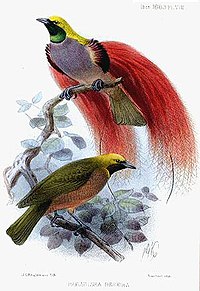
Photo from wikipedia
Sperm competition results from postcopulatory continuation of male–male competition for paternity. The level of sperm competition is predicted to be highest in species with greater polyandry and weakest in monogamous… Click to show full abstract
Sperm competition results from postcopulatory continuation of male–male competition for paternity. The level of sperm competition is predicted to be highest in species with greater polyandry and weakest in monogamous pairs. Sperm competition levels can be indexed using traits that reflect male investment in fertilization, particularly relative testes mass (RTM). However, the relationship between RTM and levels of sperm competition may also be influenced by precopulatory competition selecting for higher levels of testosterone, also produced by the testes. To test the relationship between RTM and both pre- and postcopulatory male–male competition we compared two bathyergid mole-rat species, the promiscuous Georychus capensis and the monogamous eusocial Fukomys damarensis. The promiscuous species had not only larger RTM, but also a greater proportion of spermatogenic tissue, maximizing germ cell production as well. Conversely, the eusocial species had smaller testes, but a higher proportion of interstitial tissue (which contains the androgenic Leydig cells) and higher levels of testosterone. Consequently, testicular traits as well as testes mass may be under selection, but these are not normally measured. More research is required on relative investment in different testicular traits in relation to both pre- and postcopulatory selection pressures.
Journal Title: Journal of Mammalogy
Year Published: 2023
Link to full text (if available)
Share on Social Media: Sign Up to like & get
recommendations!